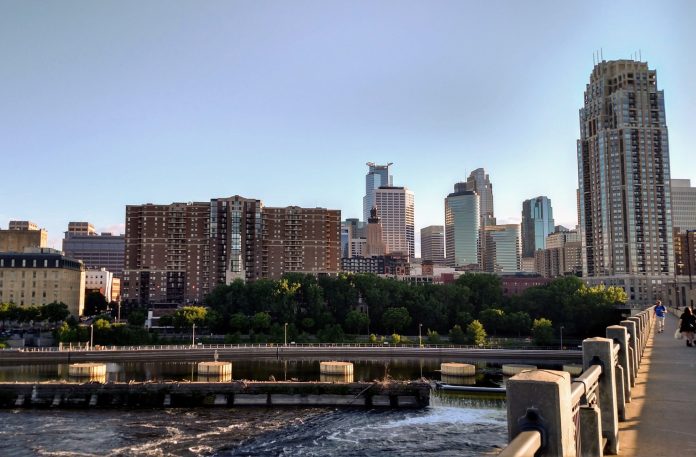Just like Seattle, Minneapolis has several high-profile political races that could push the city in a more progressive and urbanist direction. Mayor Betsy Hodges, the incumbent, has drawn a wealth of challengers even though she has overseen some policy successes in her first term. Many council seats could change hands, too. Before I offer a stab at ranking the candidates (Minneapolis has ranked choice voting) and early voting starts today, I’ll give an overview of the political and urbanism landscape in the “Mini Apple.” First lesson, few people refer to it as the Mini Apple, even if I think it’s a funny nickname. I grew up in Minnesota and lived in Minneapolis for three years and Saint Paul for a year and a half before moving to Seattle.
Police Shootings And Racial Disparities
Minneapolis has been in the news for the wrong reasons lately. In July, an Australian woman was shot and killed by a Minneapolis Police Department (MPD) officer who was sitting inside a squad car at the time. Mayor Hodges fired Minneapolis Police Chief Janee Harteau shortly thereafter, leading some to ask why police chiefs are typically not fired when their officers kill a black man–for example when Jamar Clark was shot and killed by a MPD officer in 2015. Hodges appointed as acting police chief Medaria Arrandondo, a black police officer.
Last year another Twin Cities police shooting that went viral was when Philando Castile was shot and killed in 2016 by Officer Jeronimo Yanez with the Saint Anthony Police–a suburb just north of Minneapolis–during a routine traffic stop in Falcon Heights–another suburb just east. Castile’s girlfriend Diamond Reynolds watched in horror and filmed the aftermath with her phone to try to keep her four-year-old daughter calm and safe as Philando bled out and Yanez continued to point his gun at them.
Police shootings, racial violence, and criminal justice reform (or the lack thereof) are becoming a campaign issue, and so should they become a major issue for the urbanist movement. One place urbanist can help is increasing awareness of the role structural racism played in the history of American cities. White flight to government-subsidized suburban sprawl left cities to minority communities who overcame divestment to not only stabilize these abandoned neighborhoods, but also to create vibrant places. The success of minority-led urban communities ultimately drew suburban whites back into cities but the influx a wealthier group has displaced many of the people of color who made these places what they are. Along with displacement, gentrification means the flourishing of cultures incubated in cities is also imperiled as more homogenized white or globalized culture takes over, often bringing cookie cutter chain restaurants and franchise stores.
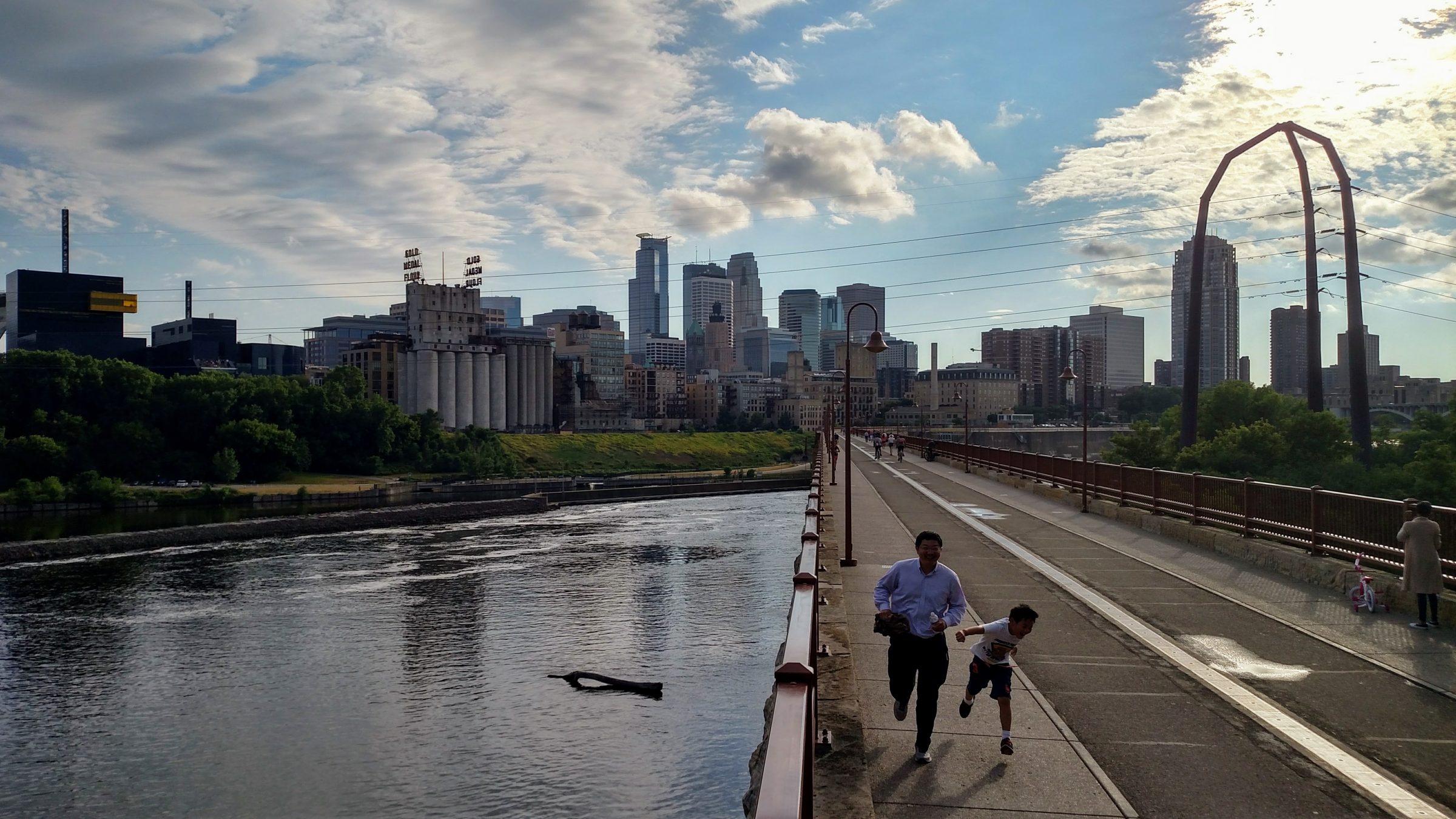
Context: Needs Emerging During Growth Spurt
In some ways, Minneapolis is a good city for an urbanist. It boasts a robust park system built on an Olmsted plan. After long (and sometimes brutal) winters Minnesotans tend to flock to the streets, beaches, patios, playfields, farmers markets, and bike trails when spring finally arrives to make up for lost time. Minnesota’s urbanist community also has a great marketplace for idea with the Streets.mn blog.
The off-street bike and pedestrian network is something to behold starting with Minneapolis’ crown jewel, the Midtown Greenway, a bike freeway through the heart of South Minneapolis. The on-street network still needs work but is probably more functional than Seattle’s, whose progress was stunted by the malaise of the Murray administration. One sign of progress on Minneapolis on-street network is a protected bike lane that will open as soon as the reconstruction of Washington Avenue downtown is completed.
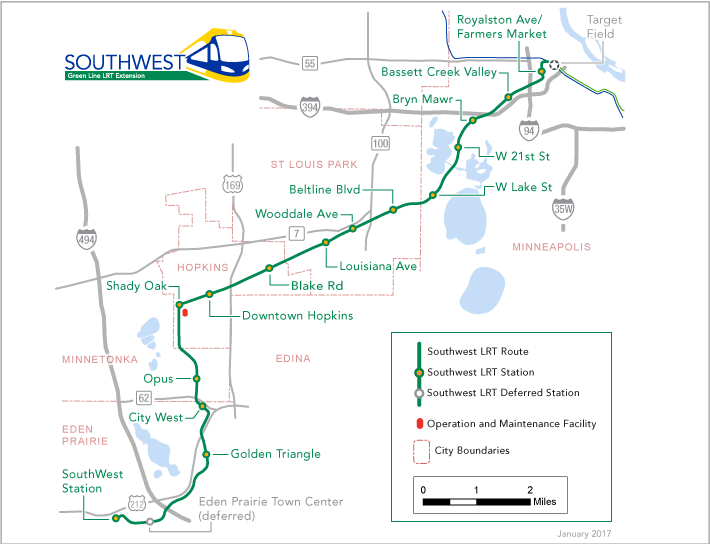
The addition of the Green Line, a center-running mostly at-grade light rail line which connects downtown Minneapolis to downtown Saint Paul, was a huge boost to transit. Minneapolis also got the jump on Seattle opening its first light rail line running to the airport and Mall of America in 2004 (now known as the Blue Line). Unfortunately further progress on the light rail network is in limbo following the Republican takeover of both the Whitehouse and Minnesota’s state legislature last year. Metro Transit is still hoping to open Southwest Light Rail in 2021 despite delays and mounting uncertainty about funding.
Meanwhile, things appear to be moving more smoothly for Bottineau Light Rail, which would extend the Blue Line to the northwest suburbs and terminate in Brooklyn Park. The alignment leaves much to be desired–mostly avoiding population centers within Minneapolis to bee line for suburban park and rides. Northwest light rail could be turned into a much bigger asset by running it through North Minneapolis rather than through Theodore Wirth Regional Park for no apparent reason other than it’s easy and cheap–the 13-mile extension has an expected cost of $1.5 billion. With the project on track to open in 2022, it seems unlikely policymakers will change course.
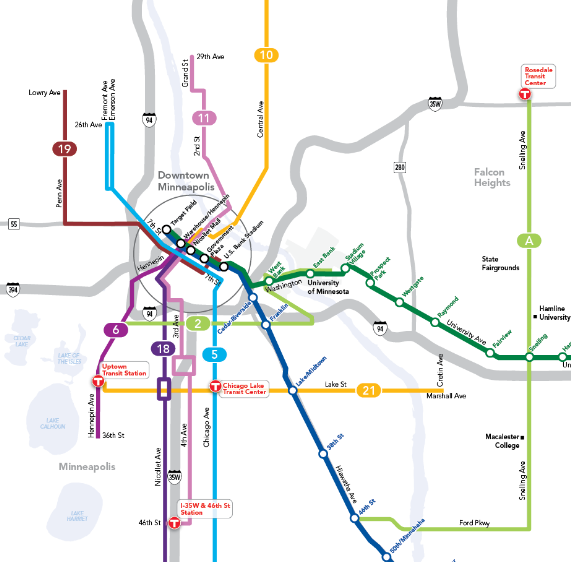
Looking beyond light rail, bus service is spotty, which is reflected in ridership data. Metro Transit has implemented one bus rapid transit (BRT) line (the “A line” on Snelling Avenue in Saint Paul) and is planning more, although they’ve tilted toward suburban commuter service rather than a reliable urban grid. The flagship of the Twin Cities bus network is far and away the Route 5, which runs from Mall of America to Brooklyn Center–with average weekday ridership of 19,000. That beats Seattle’s RapidRide E which averaged 17,000 weekday rides at last count (the E is a 13-mile route while the 5 is about 20 miles.) Meanwhile, Minnesota’s new A line BRT clocked in just above 4,700 last year.
Minneapolis has welcomed new housing in some select areas, but has struggled to implement more permissive zoning more broadly. Big population gains may make that mission more urgent. After bottoming out around 368,000 in the 1990 census, Minneapolis has likely seen its population surpass 420,000 in 2017. On a pace of more than 6,000 new residents per year since 2010, Minneapolis is growing steadily. Much of that population growth had been concentrated in Downtown, Dinkytown, and Uptown, where many apartment buildings have sprouted near the Midtown Greenway. Development was relatively slow to take off along the Blue Line, but has recently picked up there and along the newer Green Line.
Forging Urban Solutions
What should a candidate seek to make of these trends and the problems they present? The mayor and council cannot control the SWLRT funding, a big chunk of which is expected from the Feds through the New Starts program. However, the mayor and council will have a big say in optimizing the bus network. Metro Transit recently rolled out Transit Signal Priority (TSP) on the flagship Route 5 in hopes of keeping the busy bus on schedule. Lavishing attention on the city’s workhorse buses could help Metro Transit reverse its recent ridership losses, which have been blamed on cheap gas but certainly aren’t helped by slow routes stuck in traffic due to a lack of dedicated lanes.
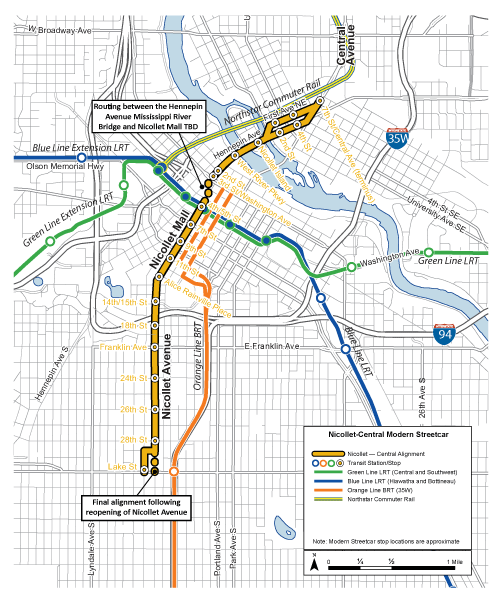
Candidates could also have influence in guiding streetcar projects being kicked around now or in making the case for a bold new project. If SWLRT does keep moving ahead, the City of Minneapolis must come up with a plan to fund Midtown LRT which would provide a speedy alternative to the woefully slow Route 21. Civic leaders will need to follow a delicate path to sell the project of building light rail alongside the Midtown Greenway, which will temporarily interrupt the heavily used bike trail and inevitably draw out fears of decreasing quality on the trail. A good plan should be able to both ensure long-term viability of the greenway and provide excellent light rail service. The legacy rail trench made the Midtown Greenway possible, and it also what makes grade-separated light rail so reasonably priced in the corridor.
The bold idea I had in mind is a subway underneath Nicollet Avenue to relieve a transit bottleneck in Downtown Minneapolis. Unfortunately, the city is in the midst of a pricey Nicollet Mall beautification project that represents a squandered opportunity to do a cut-and-cover tunnel and a new excuse not to initiate one anytime soon. Instead the City has been exploring building a streetcar on Nicollet and Central Avenues, which would be much cheaper than a subway but not offer much in the way of time savings for transit users. When my new home passed a $54 billion transit package, I can’t help but dream bigger for my old home state. They identified a great corridor for improvement but selected the wrong technology; subway or a transit tunnel would attract many more new riders via its great speed and comfort and would scale up with demand much better.
So watch out for my expatriate attempt at candidate rankings next week. All 13 Minneapolis City Councilmembers are up for reelection as is both mayor of Minneapolis and neighboring Saint Paul. Police accountability and criminal justice reform are turning into big issues in light of the recent tragedies and a big reason why many expect Mayor Hodges to struggle to win reelection. Some of the best candidates combine strong stands on police accountability with impeccable urbanist values. Janne Flisrand in Ward 7 comes to mind as a housing policy consultant who’s also vice chair at the aforementioned Streets.mn, which did an interview with her here. That’s one endorsement–the rest are next week!
Doug Trumm is publisher of The Urbanist. An Urbanist writer since 2015, he dreams of pedestrian streets, bus lanes, and a mass-timber building spree to end our housing crisis. He graduated from the Evans School of Public Policy and Governance at the University of Washington in 2019. He lives in Seattle's Fremont neighborhood and loves to explore the city by foot and by bike.

